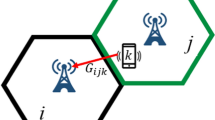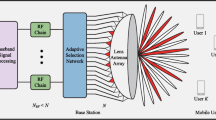Abstract
In this work heuristic ant colony optimisation (ACO) procedure is deployed in conjunction with lattice reduction (LR) technique aiming to improve the performance-complexity tradeoff of detection schemes in MIMO communication. A hybrid LR-ACO MIMO detector using the linear minimum mean squared error (MMSE) criterion as initial guess is proposed and compared with two other traditional (non)linear MIMO detectors, as well as with heuristic MIMO detection approaches from the literature, in terms of both performance and complexity metrics. Numerical results show that the proposed LR-ACO outperforms the traditional ACO-based MIMO detectors and the ACO detector with the MMSE solution as initial guess, with a significant complexity reduction while is able to reach full diversity degree in all scenarios considered, including different channel correlation levels, modulation orders, and antennas configuration.










Similar content being viewed by others
Notes
Block fading channel assumption.
Defined as the asymptotic slope of the BER curve in each number of antennas scenario.
A flop is defined as an addition, subtraction, multiplication or division between two floating point numbers
References
Angélico, B., Burt, P., Jeszensky, P., Hodgkiss, W., & Abrão, T. (2011). Performance analysis of a single-user miso ultra-wideband time reversal system with dfe. Telecommunication Systems, 46, 333–342. doi:10.1007/s11235-010-9295-1.
Aubert, S., Nasser, Y., & Nouvel, F. (2012). Lattice reduction-aided minimum mean square error k-best detection for mimo systems. In 2012 International conference on computing, networking and communications (ICNC) (pp. 1066–1070). doi:10.1109/ICCNC.2012.6167371.
Dorigo, M., Birattari, M., & Stutzle, T. (2006). Ant colony optimization. IEEE Computational Intelligence Magazine, 1(4), 28–39. doi:10.1109/MCI.2006.329691.
de Paula Marques, M., Abrão, T., Adaniya, M. H., Sampaio, L. H. D., & Jeszensky, P. J. E. (2013). Ant colony optimization for resource allocation and anomaly detection in communication networks. In T. Abrão (Ed.), Search algorithms for engineering optimization, (chap. 8, pp. 1–34). InTech Open.
Foschini, G. J., & Gans, M. J. (1998). On limits of wireless communications in a fading environment when using multiple antennas. Wireless Personal Communications, 6, 311–335.
Golub, G. H., & Loan, C. F. V. (1996). Matrix computations. Maryland: Johns Hopkins University Press.
Gowrishankar, R., Demirkol, M., & Yun, Z. (2005). Adaptive modulation for mimo systems and throughput evaluation with realistic channel model. In 2005 International conference on wireless networks, communications and mobile computing (vol. 2, pp. 851–856). doi:10.1109/WIRLES.2005.1549523.
He, Q., Feng, Z., & Zhang, P. (2013). Reconfiguration decision making based on ant colony optimization in cognitive radio network. Wireless Personal Communications, 71(2), 1247–1269. doi:10.1007/s11277-012-0872-3.
Jaldén, J., & Ottersten, B. (2005). On the complexity of sphere decoding in digital communications. IEEE Transactions on Signal Processing, 53(4), 1474–1484. doi:10.1109/TSP.2005.843746.
Khurshid, K., Irteza, S., & Khan, A. A. (2010). Application of ant colony optimization based algorithm in mimo detection. In CEC10-IEEE congress on evolutionary computation (pp. 1–7), doi:10.1109/CEC.2010.5586173.
Kotti, M., Benhala, B., Fakhfakh, M., Ahaitouf, A., Benlahbib, B., Loulou, M., et al. (2011) Comparison between pso and aco techniques for analog circuit performance optimization. In 2011 International conference on microelectronics (ICM) (pp. 1–6). doi:10.1109/ICM.2011.6177367.
Lain, J. K., & Chen, J. Y. (2010). Near-mld mimo detection based on a modified ant colony optimization. IEEE Communications Letters, 14(8), 722–724. doi:10.1109/LCOMM.2010.08.100347.
Larsson, E. G. (2009). MIMO detection methods: How they work. IEEE Signal Processing Magazine, 26(3), 91–95.
Marinello, J. C., de Souza, R. N., & Abrão, T. (2012). Ant colony input parameters optimization for multiuser detection in ds/cdma systems. Expert Systems with Applications, 39(17), 12,876–12,884. doi:10.1016/j.eswa.2012.05.005.
Milford, D., & Sandell, M. (2011). Simplified quantisation in a reduced-lattice mimo decoder. IEEE Communications Letters, 15(7), 725–727. doi:10.1109/LCOMM.2011.051011.110485.
Mostagi, Y. M., & Abrão, T. (2012). Lattice-reduction-aided over guided search mimo detectors. International Journal of Satellite Communications Policy and Management, 1(2/3), 142–154.
Rahhal, J., & Abu-Al-Nadi, D. (2010). Pre-coding for mimo systems in frequency-selective fading channels. Wireless Personal Communications, 55(4), 591–605. doi:10.1007/s11277-009-9821-1.
Rusek, F., Persson, D., Lau, B. K., Larsson, E., Marzetta, T., Edfors, O., et al. (2013). Scaling up mimo: Opportunities and challenges with very large arrays. IEEE Signal Processing Magazine, 30(1), 40–60. doi:10.1109/MSP.2011.2178495.
Seyman, M. N., & Taspinar, N. (2013). Pilot tones optimization using artificial bee colony algorithm for mimo ofdm systems. Wireless Personal Communications, 71(1), 151–163.
Telatar, E. (1999). Capacity of multi-antenna gaussian channels. European Transactions on Telecommunications, 10(6), 585–595. doi:10.1002/ett.4460100604.
Torabi, E., Mietzner, J., & Schober, R. (2008). Pre-equalization for pre-rake MISO DS-UWB systems. In IEEE international conference on communications (ICC ’08) (pp. 4861–4866).
Tse, D., & Viswanath, P. (2011). Fundamentals of wireless communications (1st ed.). England: Cambridge University Press.
Uma, K., Palanisamy, P., & Poornachandran, P. (2011). Comparison of image compression using ga, aco and pso techniques. In 2011 International conference on recent trends in information technology (ICRTIT) (pp. 815–820). doi:10.1109/ICRTIT.2011.5972298.
Wang, B., & Wang, L. (2012). A novel artificial bee colony algorithm for numerical function optimization. In 2012 Fourth international conference on computational and information sciences (ICCIS) (pp. 172–175). doi:10.1109/ICCIS.2012.32.
Wang, P., & Le-Ngoc, T. (2011). A list sphere decoding algorithm with improved radius setting strategies. Wireless Personal Communications, 61(1), 189–200. doi:10.1007/s11277-010-0018-4.
Wübben, D., Bohnke, R., Kuhn, V., & Kammeyer, K. D. (2004). Near-maximum-likelihood detection of mimo systems using mmse-based lattice reduction. In 2004 IEEE international conference on communications (vol. 2, pp. 798–802). doi:10.1109/ICC.2004.1312611.
Wübben, D., Seethaler, D., Jaldén, J., & Matz, G. (2011). Lattice reduction. IEEE Signal Processing Magazine, 28(3), 70–91. doi:10.1109/MSP.2010.938758.
Zelst, A. V., & Hammerschmidt, J. S. (2002). A single coefficient spatial correlation model for multiple-input multiple-output (mimo) radio channels. In Proceedings of the URSI XXVIIth general assembly (pp. 1–4).
Zhao, N., Wu, Z., Zhao, Y., & Quan, T. (2012). Population declining ant colony optimization multiuser detection in asynchronous cdma communications. Wireless Personal Communications, 62(4), 783–792. doi:10.1007/s11277-010-0093-6.
Zhiwei, L., Xiaoming, P., Png, K. B., & Chin, F. (2007). Kronecker modeling for correlated shadowing in UWB MIMO channels. In IEEE wireless communications and networking conference (WCNC 2007) (pp. 1583–1587).
Acknowledgments
This work was supported in part by the National Council for Scientific and Technological Development (CNPq) of Brazil under Grants 202340/2011-2, 303426/2009-8, in part by the Araucaria Foundation of PR-Brazil under Grant 007/2011, in part by CAPES-Brazil (scholarship), and in part by Londrina State University—Paraná State Government (UEL).
Author information
Authors and Affiliations
Corresponding author
Additional information
Part of this work has been presented in the IEEE-WCNC’13 Conference.
Rights and permissions
About this article
Cite this article
Marinello, J.C., Abrão, T. Lattice Reduction Aided Detector for MIMO Communication Via Ant Colony Optimisation. Wireless Pers Commun 77, 63–85 (2014). https://doi.org/10.1007/s11277-013-1495-z
Published:
Issue Date:
DOI: https://doi.org/10.1007/s11277-013-1495-z




